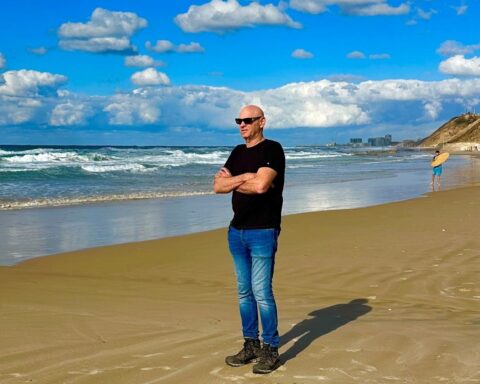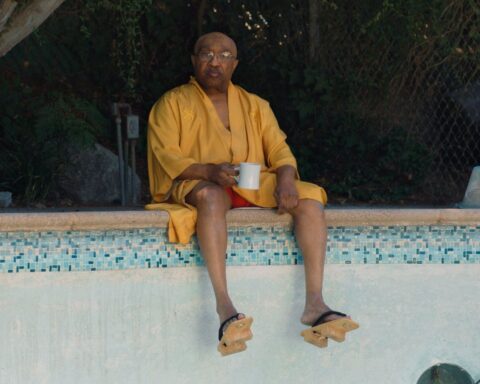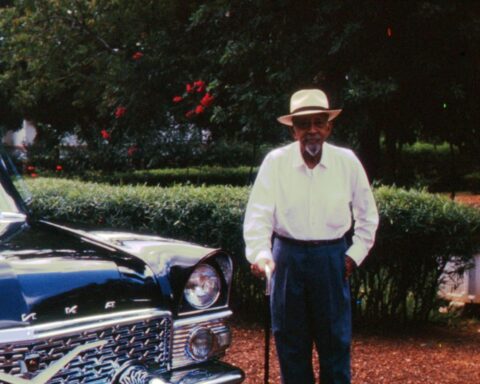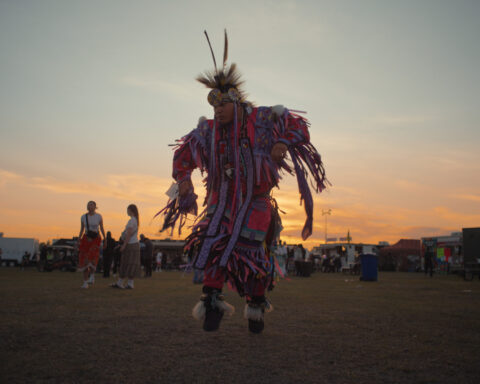Let’s talk about some typical Canadian documentaries. Where do they take place? In rural India, where Hindu girls practice military drills and swear death to their religious enemies while their peers preen for the nation’s biggest beauty pageant a few hours away? In southwest Mexico, where a poetry-spouting intellectual puffs a pipe through a balaclava and seizes the world media’s attention by leading an Indigenous revolt against free trade? In China, where a teenage girl spurns her parents’ sacrifices to put her through school by taking a factory job?
These three films—Nisha Pahuja’s The World Before Her (2012), Nettie Wild’s A Place Called Chiapas (1998) and Lixin Fan’s Last Train Home (2009)—have certain things in common. They all deal with people struggling with the wrenching conflict between modernity and tradition in developing countries.
None feature Canadian settings or characters. None of the directors were even born in Canada. Yet they are Canadian films, not just because they are supported by tax dollars, but also because they reflect global perspectives shared by contemporary Canadians.
Over the past 25 years or so, in the current globalisation era, there has been a steady flow of such Canadian films. Yung Chang’s majestic Up the Yangtze (2007) takes us on a tourist boat on a farewell trip through a soon-to-be-flooded river valley. Jennifer Baichwal’s Manufactured Landscapes (2006), again set predominantly in China, follows the work of photographer Edward Burtynsky and his grotesquely sublime images of environmental damage. Sturla Gunnarsson’s diary film Monsoon (2014) is a meditation on the relationship between Indian culture and weather. Naomi Klein’s books on the movement of global capital (The Shock Doctrine) and environmental threat (This Changes Everything) were made into docs. Peter Raymont made films that examined the aftermath of the Chilean coup (A Promise to the Dead), the Nicaraguan Revolution (The World is Watching) and the Rwandan genocide (Shake Hands with the Devil).
Traditionally, national media institutions such as the National Film Board (NFB) and the Canadian Broadcasting Corporation (CBC) have narrowly defined themselves as mirrors to the population mandated to public education and nation building. The CBC’s 2015 strategic plan, for example, declares that it airs “opinions and ideas that reflect the diversity and complexity of Canadian society, and that add depth to its democratic life.” The NFB, as all of its mandates state, exists to “reflect Canada to itself and to the world.”
As we see by the films though, Canadian filmmakers are often less interested in holding up a mirror than opening a window to see the bigger world. In its last strategic plan (2013-2018), the NFB amended its mission statement to include providing new perspectives on “Canada and the world from Canadian points of view.”
There is a common perspective to these films with values that seem so self-evident as to be ideologically invisible: the equality of women, stewardship of the environment, cultural diversity and the struggle to balance progress with preservation.
At least they seemed commonplace until the world took a seismic shift in the last few months. Shaken by terrorist attacks and hate crimes, shocked by Britain’s referendum exit from the European Union and the election of a wall-building, anti-immigrant American president, Canada has suddenly begun looking like an outlier. Recent English and American press stories have questioned Canada’s international position: “The last liberals?” (The Economist), the first “post-national country” (The Guardian) or “Canada, Leading the Free World” (The New York Times). Canada finds itself as an accidental volunteer cast in the role of the virtuous alternative.
A brief consideration of Canada’s historical record of racism and aboriginal abuses undercuts any extended smugness. Now seems a good moment to consider some of the historical filters that govern how Canadians frame the global reality.
Most obviously, Canadians have become steeped in multiculturalism and often live with hyphenated nationalities. That’s turned our filmmakers into natural border-hopping global citizens. Their subjects include the heavens and hells of human experience: genocide, war, water, stupidity, sugar, pornography, New Age spirituality, corporations, sewage, the Occupy movement, Uyghur prisoners, documentary film itself and, in Peter Mettler’s Gambling, Gods and LSD (2002), the universal quest for ecstasy.
We also know that contemporary Canadian documentary filmmakers stand within a tradition of innovation and social conscience. The NFB, the maternity ward of most of our documentary culture, was international in its inception. The Board’s Scottish founder, John Grierson, created a team that included English men, Canadian women, Scots, the young Albertan artist Colin Low, the Russianborn animator Alexander Alexeiff, the Dutch documentarian Joris Ivens and the American Irving Jacoby. They used film technology to create a sense of cohesion in a regionally and ethnically fragmented country. As Grierson wrote in a letter back to England: “No nation except Russia has, in her own form and character, pursued more imaginatively the conception of diversity in unity.”
The NFB’s success at branding Canada to the world was spectacular. By the end of the war, the global audience for the Board’s newsreels was estimated at more than 40 million a week.
In the years during and following the war, the Canadian government continued to be assertively internationalist, a member of the post-Empire Commonwealth of Nations, the United Nations and the North Atlantic Treaty Organization. Canada went on an embassy-building binge (from six embassies in 1939 to 93 in 1967) with the United Nations as its primary diplomatic front and the Film Board encouraging Cold War-era Canadians to think of themselves as vigilant global citizens. To a great degree, the NFB followed the programme. As film professor Zoë Druick notes in Projecting Canada: Government Policy and Documentary Film at the National Film Board, many NFB films had an agenda promoting the benefits of multinationalism: “The image of Canada as a mini United Nations is made explicit.”
Bethune, Donald Brittain, provided by the National Film Board of Canada
An absence of a central national ideology became a kind of virtue: “Canada is the only country in the world that knows how to live without an identity,” Marshall McLuhan said in 1963. Prime Minister Justin Trudeau echoed this idea in October 2015 when he referred to Canada as the first “post-national country” with no core identity.
In 1971, Canada became the first country in the world to adopt multiculturalism as an official policy—a work-around to the impasse of French-English bilingualism and a recognition of our already multi-ethnic personality. The emphasis on ethnic independence, rather than assimilation, coincided with an increasingly diverse population and drew more non-European visible minorities. Multiculturalism also helped define Canada’s differences from its U.S. neighbour, which emphasises assimilation and American exceptionalism.
Though many Canadian documentaries of the 1960s by, say, Allan King, Pierre Perrault or Donald Brittain, held a mirror up to Canadian society, other filmmakers saw themselves as chroniclers of the wider history, especially American militarism. Beryl Fox’s 1965 CBC documentary The Mills of the Gods: Viet Nam was a rhetorical reality-check against U.S. propaganda. Later, Australian filmmaker Michael Rubbo, working for the NFB, created the very funny and innately political Waiting for Fidel (1974), a prototype for the first-person work of Nick Broomfield and Michael Moore.
Waiting for Fidel, Michael Rubbo, provided by the National Film Board of Canada
By the early eighties, Canadian cultural policy through Telefilm shifted away from documentaries toward feature fiction film development, again with a distinctly internationalist orientation. (With 54 international production treaties for film and television, Canada is rivalled only by France.) The NFB was mandated with a more domestic role, focusing on “social needs of minority and specialised audiences,” including women, aboriginal Canadians and visible minorities. Having a “specialized audience” did not preclude a global perspective, at least in the NFB’s interpretation of their role.
Terre Nash’s If You Love This Planet, released in 1982 through NFB’s feminist unit Studio D, featured a lecture by Dr. Helen Caldicott on the dangers of nuclear weapons. Suppressed by the U.S. Department of Justice as “foreign political propaganda,” the film won an Academy Award for best documentary short and inspired Prime Minister Pierre Elliott Trudeau’s world peace tour to reduce nuclear arms.
If You Love This Planet, Terre Nash, provided by the National Film Board of Canada
Historically, then, Canadian filmmakers and politicians have always been internationally oriented. It’s an attitude that conforms with sociological data about Canadians as a whole. We have the highest immigration rate in the world—300,000 people last year— with one in five Canadians being foreign-born. Two thirds of us hold passports as opposed to one third of Americans. Three million Canadian citizens don’t even live in the country.
According to the 2008 Canada’s World Poll, the biggest survey to date on how Canadians see the world, we’re at our most cohesively “Canadian” when looking outward. The survey also notes that “in some respects [Canadians] feel they are as much citizens of the world as they are citizens of their own country.”
Three quarters of Canadians follow international news. The same percentage has travelled beyond Canada and the United States. 40 percent of Canadians contribute to international causes.
Environmental worries are considered the number one threat to human survival. Almost all Canadians believe that Canada’s support of environmental practices, human rights, multiculturalism and immigration sets a good example for the world.
These same values shape our documentaries. Take, for example, the concern with the environment: Canada’s large land mass, long coastline and resource-based economy make it vulnerable to climate change and pollution. Greenpeace was founded in Vancouver more than 45 years ago. The monumental landscapes in films such as Up the Yangtze, Manufactured Landscapes, Watermark and Monsoon constitute a kind of Canadian genre built around sublime visual images and the collision of human and natural forces.
Canadians are naturals at making films on multiculturalism. It’s a policy that began in Canada and was later adopted by most countries in the European Union. Essentially, it guarantees the right to sit on the identity fence. Think of Allan King’s The Dragon’s Egg (1999), which is about Estonians and their ethnic Russian neighbours struggling to learn democracy in a country freed from the Soviet Union, or Tahani Rached’s Four Women of Egypt (1997) about Christian and Muslim women and their shared history in an Egypt already fracturing under the rule of Mubarak. Both situations are far more fraught with difficulties than those experienced in Canada. The insistence on adopting one dominant identity, as Nobel Prize-winning economist Amartya Sen wrote, is “the denial of an important liberty of a person who can decide on their respective loyalties to different groups (to all of which he or she belongs).”
In ideological impasses, Canadian documentaries tend to stress the benefits of divergent thinking. Canadian director Paul Cowan and Palestinian animator Omar Shomali’s hybrid animated documentary The Wanted 18 (2014) is a serio-comic chronicle of Palestinians using a covert dairy farm where raising 18 cows offers a form of resistance. Or, for another jump outside the box, director Elle Flanders’ Zero Degrees of Separation (2005) examines the Middle East conflict through the perspectives of two Palestinian and Israeli gay couples.
Multiculturalism inspires new genre innovations. The Iranian-Canadian filmmaker and journalist Maziar Bahari, whose book about his imprisonment was made into Jon Stewart’s feature film Rosewater, is credited as the first Muslim to make a film about the Holocaust. His film The Voyage of the St. Louis (1994) tells of a boatload of over 900 Jewish refugees escaping Germany in 1939 and their unsuccessful attempts to find asylum in the West.
In the early nineties, Ali Kazimi returned to his native India from Canada to make his first documentary feature Narmada: The Valley Rises (1994). The film documents a non-violent protest march, inspired by Mahatma Gandhi, against a dam project that was supported by the World Bank and threatened to displace more than 160,000 people. Back in Canada, Kazimi made a personal documentary about his formal relationship to Indigenous photographer Jeff Thomas—both politically active “Indians” armed with cameras—in Shooting Indians (1997). He then made Continuous Journey (2004), which is about a boatload of over 350 rejected Indian immigrants, travelling on the Komagata Maru, who were refused entry into Canada in 1914 in an episode that mirrored the aforementioned story of the St. Louis. (Kazimi later wrote a book about this infamous incident, Undesirables.) In 2016, Prime Minister Justin Trudeau apologised for the racist wrong perpetrated against Indians by the Canadian government. Kazimi’s critical gaze on Canadian society is a heartening instance of documentarians performing a crucial function in this country as well as abroad.
Many Canadian-born citizens find themselves attached to other cultures. Like Kazimi, they’re concerned about the world but also about Canada’s shifting ideals and identity. Three recent films—and there are more—examine bifurcated identities. Ann Marie Fleming’s The Magical Life of Long Tack Sam (2003) is a partially animated documentary on her famous great grandfather, a Chinese born magician, whose feats descended into obscurity. In Corey Lee’s Legend of a Warrior (2012), the biracial director bonds with his father through their interest in Chinese martial arts. Hubert Davis’s Oscar-nominated short Hardwood (2004) is a personal doc about growing up as a child of biracial parents, one of whom is an American basketball player.
Given that Canada is increasingly seen as carrying the torch for liberty and international co-operation, and that our documentary filmmakers represent typical Canadian perspectives on the world, there’s an obvious conclusion: Canadian documentaries need to be more widely seen abroad.
Back in 1995, the Liberal government identified culture as the “third pillar” of diplomacy to attract immigrants, encourage investment and tourism and build security. Follow-through, though, was half-hearted. The potential of this kind of foreign affairs was emphasised in the 2009 book Branding Canada: Projecting Soft Power Through Public Diplomacy by former Department of Foreign Affairs strategist Eric Potter.
Potter makes a strong case that Canada “is one of the few countries that can both defend the inherent benefits of cultural diversity to a global community and also be a significant exporter of culture.”
Prime Minister Trudeau, are you listening? To paraphrase Bono and President Barack Obama, the world needs more Canadian documentaries, a genre that maintained high quality standards for almost 80 years. It’s difficult to imagine a more effective demonstration of cultural goodwill than showing how Canadians can frame reality with compassion and integrity.










